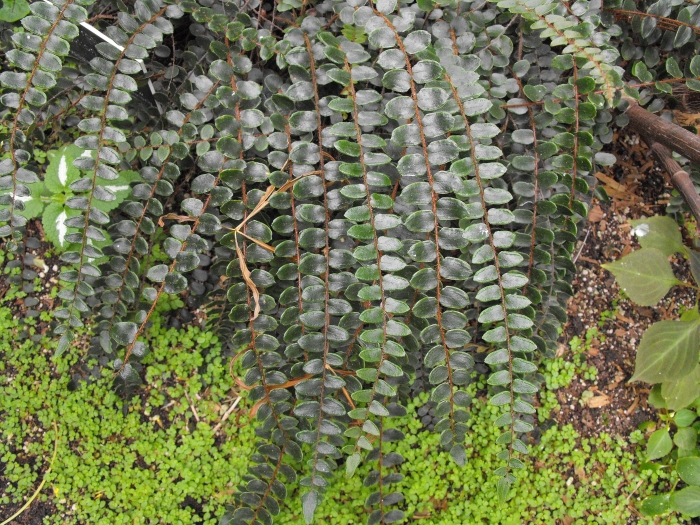Button Fern
(Pellaea rotundifolia)
Button Fern (Pellaea rotundifolia)
/
/

Stickpen
Public domain
Image By:
Stickpen
Recorded By:
Copyright:
Public domain
Copyright Notice:
Photo by: Stickpen | License Type: Public domain | License URL: https://creativecommons.org/public-domain/ | Uploader: Stickpen | Publisher: Wikimedia Commons | Title: Pellaearotundifolium.jpg | Notes: {{Information |Description={{en|1=''[[Penstemon clevelandii]]''}} |Source=originally uploaded to '''[[Flickr|Flickr]]''' as [http://www.flickr.com/photos/fboyd/3466296803/ Beardtongue] |Author=[http://www.flickr.com/photos/fboyd/ °Florian] |Date=April 2 |





















































Estimated Native Range
Summary
Pellaea rotundifolia, commonly known as Button Fern, is an evergreen fern native to the temperate rainforests and coastal scrublands of New Zealand. It typically forms a compact clump, reaching up to 12 inches (30 cm) in height and width. The fern is characterized by its numerous pairs of round, dark-green, leathery pinnae, which give the appearance of buttons lined up along the fronds that can grow up to 18 inches (460 mm) in length. The Button Fern’s unique foliage texture and shape make it a visually appealing addition to any garden or indoor space.
Button Fern is valued for its low maintenance requirements and its ability to thrive in a variety of indoor conditions, making it a popular houseplant. It is also used in shaded garden areas in zones 8 and 9, where it can provide year-round greenery. This fern prefers part shade but can tolerate low light, making it suitable for indoor environments. It requires medium amounts of water and well-drained soil to prevent root rot. While it can withstand low temperatures, it should not be exposed to freezing conditions. Button Fern is not known for significant pest or disease problems, but overwatering can lead to issues. It is not considered invasive and does not have aggressive roots, making it a safe choice for cultivation near structures or other plantings.CC BY-SA 4.0
Button Fern is valued for its low maintenance requirements and its ability to thrive in a variety of indoor conditions, making it a popular houseplant. It is also used in shaded garden areas in zones 8 and 9, where it can provide year-round greenery. This fern prefers part shade but can tolerate low light, making it suitable for indoor environments. It requires medium amounts of water and well-drained soil to prevent root rot. While it can withstand low temperatures, it should not be exposed to freezing conditions. Button Fern is not known for significant pest or disease problems, but overwatering can lead to issues. It is not considered invasive and does not have aggressive roots, making it a safe choice for cultivation near structures or other plantings.CC BY-SA 4.0
Plant Description
- Plant Type: Fern
- Height: 0.5-1 feet
- Width: 0.5-1 feet
- Growth Rate: Moderate
- Flower Color: N/A
- Flowering Season: Non-Flowering
- Leaf Retention: Evergreen
Growth Requirements
- Sun: Part Shade
- Water: Medium
- Drainage: Medium
Common Uses
Border Plant, Deer Resistant, Drought Tolerant, Low Maintenance, Potted Plant, Rabbit Resistant
Natural Habitat
Native to the temperate rainforests and coastal scrublands of New Zealand
Other Names
Common Names: New Zealand Cliff Brake
Scientific Names: , Pellaea rotundifolia, Pteris rotundifolia, Allosorus rotundifolius, Hemionitis rotundifolia, Platyloma rotundifolium,
GBIF Accepted Name: Pellaea rotundifolia (G.Forst.) Hook.